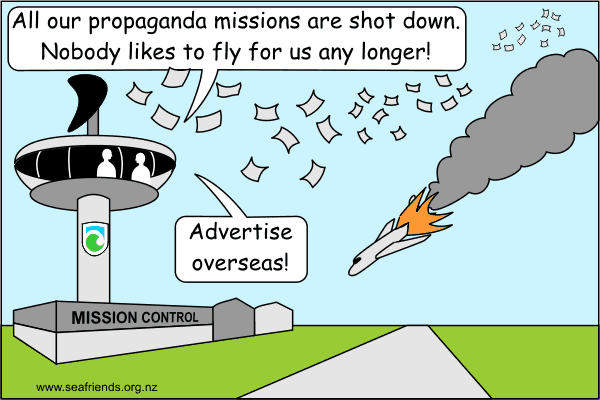 When
a government department is in need of support for its unproven ideologies,
it often looks overseas for experts that are only too willing to
be invited for exorbitant pay. Both nationally and internationally a travelling
circus mushrooms, whose performers entertain business lunches, conferences
and parliaments. One's memory does not need to be jogged much to remember
the issues of nuclear weapons, nuclear energy, deregulation, privatisation,
free markets, corporate take-overs, financial management, global warming,
genetic engineering, to name a few. Recently the Department of Conservation
has armed itself with the offensive weapon of propaganda, to win
the public for a cause it cannot prove. But the public is gullible only
up to a point, becoming steeled in fending off persuasive attacks while
learning to distinguish fact from fallacy. For its rounds of propaganda,
DoC has an unlimited budget with which it pays speakers, writers and presenters.
It also uses this budget to influence the media. That is why web sites
like Seafriends have become a haven for those who seek the truth and who
wish to do the right thing for the right reasons at the right time.
Just imagine what good could be done with the amounts wasted on false propaganda!
Do
we really want our government departments to behave like this?
When
a government department is in need of support for its unproven ideologies,
it often looks overseas for experts that are only too willing to
be invited for exorbitant pay. Both nationally and internationally a travelling
circus mushrooms, whose performers entertain business lunches, conferences
and parliaments. One's memory does not need to be jogged much to remember
the issues of nuclear weapons, nuclear energy, deregulation, privatisation,
free markets, corporate take-overs, financial management, global warming,
genetic engineering, to name a few. Recently the Department of Conservation
has armed itself with the offensive weapon of propaganda, to win
the public for a cause it cannot prove. But the public is gullible only
up to a point, becoming steeled in fending off persuasive attacks while
learning to distinguish fact from fallacy. For its rounds of propaganda,
DoC has an unlimited budget with which it pays speakers, writers and presenters.
It also uses this budget to influence the media. That is why web sites
like Seafriends have become a haven for those who seek the truth and who
wish to do the right thing for the right reasons at the right time.
Just imagine what good could be done with the amounts wasted on false propaganda!
Do
we really want our government departments to behave like this? It
is quite common in society that people of power or fortune have achieved
this by dishonest means. They are the sharks of society. One would believe
that the legal profession would stand above such predicaments, but these
professionals are modern versions of ancient warriors and gladiators. Every
dispute in modern society gets settled through the courts where huge amounts
of money change hands, usually ending up in the warriors' pockets. The
difference between right and wrong is merely an amount of money as those
who have this resource have the law on their sides. Likewise, environmental
legislation, intended to do good, often ends up benefiting the wealthy
while disadvantaging the poor, not to mention unborn generations. Worse
still, decisions are left in the hands of people with very little knowledge
of the environment, as also common sense and justice become minimalised.
Is
this reallly the best we cando?
It
is quite common in society that people of power or fortune have achieved
this by dishonest means. They are the sharks of society. One would believe
that the legal profession would stand above such predicaments, but these
professionals are modern versions of ancient warriors and gladiators. Every
dispute in modern society gets settled through the courts where huge amounts
of money change hands, usually ending up in the warriors' pockets. The
difference between right and wrong is merely an amount of money as those
who have this resource have the law on their sides. Likewise, environmental
legislation, intended to do good, often ends up benefiting the wealthy
while disadvantaging the poor, not to mention unborn generations. Worse
still, decisions are left in the hands of people with very little knowledge
of the environment, as also common sense and justice become minimalised.
Is
this reallly the best we cando?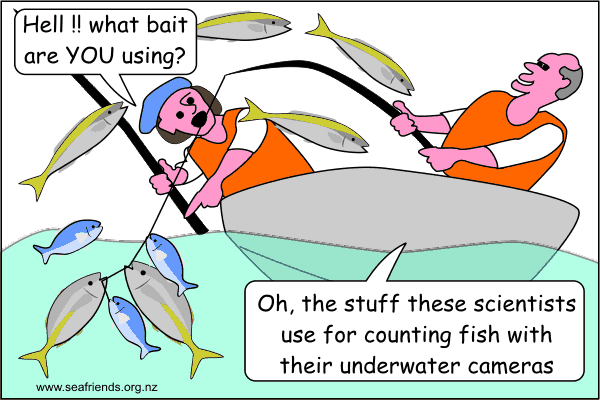 Counting
fish underwater is not easy. The traditional way is by sending divers down
to count them along transects while also identifying them on their path
(Under
Water Visual Census, UVC). But some fish like snapper are very shy,
whereas others like blue cod are inquisitive, following the divers along.
Unfortunately, also the amount of time one can spend underwater is limited
by decompression illness, the cold and what humans can endure. With the
Baited
Underwater Video (BUV), a video camera on a tripod, scientists can
stay on board while viewing the goings-on under water. They use this method
to count fish, by attracting the fish to the centre of the camera field
using a box with pilchards, and pilchards tied to the outside to actually
feed the fish. When fish numbers are at maximum, they count them and measure
their sizes from the recording. Other scientists have criticised this method
as being in conflict with principles for measuring apparatus. One
does not want such apparatus influencing the value measured. Unfortunately,
the bait does exactly that. In doing so, it exaggerates the outcome, resulting
in fish density estimates that are also unreliable. How much credence
should we give such data?
Counting
fish underwater is not easy. The traditional way is by sending divers down
to count them along transects while also identifying them on their path
(Under
Water Visual Census, UVC). But some fish like snapper are very shy,
whereas others like blue cod are inquisitive, following the divers along.
Unfortunately, also the amount of time one can spend underwater is limited
by decompression illness, the cold and what humans can endure. With the
Baited
Underwater Video (BUV), a video camera on a tripod, scientists can
stay on board while viewing the goings-on under water. They use this method
to count fish, by attracting the fish to the centre of the camera field
using a box with pilchards, and pilchards tied to the outside to actually
feed the fish. When fish numbers are at maximum, they count them and measure
their sizes from the recording. Other scientists have criticised this method
as being in conflict with principles for measuring apparatus. One
does not want such apparatus influencing the value measured. Unfortunately,
the bait does exactly that. In doing so, it exaggerates the outcome, resulting
in fish density estimates that are also unreliable. How much credence
should we give such data?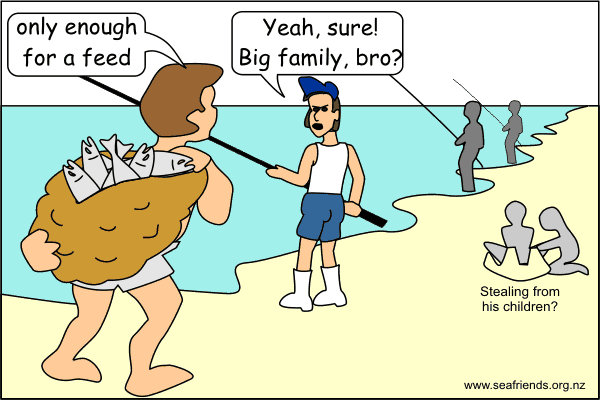 Every
fisherman thinks himself responsible, taking only what is reasonable,
but outside imposed countable bag limits, this is a rather subjective
measure. The fact is that as the number of fishermen increases, the available
fish stocks decrease due to overfishing and pollution. It could be said
that there is little merit left in fishing for sport (fame?), for fun (habit?)
or even for need (greed?). Can obese anglers justify their need?
So what should we do?
Every
fisherman thinks himself responsible, taking only what is reasonable,
but outside imposed countable bag limits, this is a rather subjective
measure. The fact is that as the number of fishermen increases, the available
fish stocks decrease due to overfishing and pollution. It could be said
that there is little merit left in fishing for sport (fame?), for fun (habit?)
or even for need (greed?). Can obese anglers justify their need?
So what should we do?
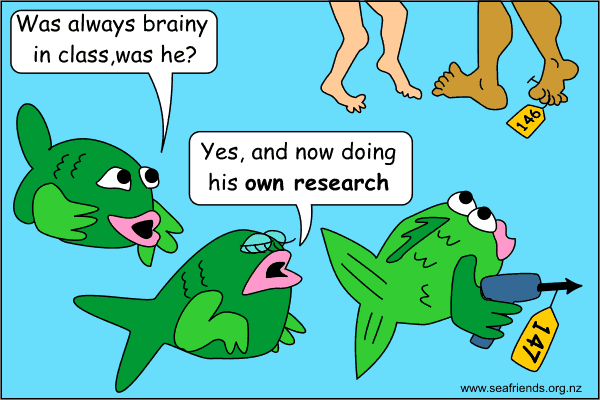 Fish
tagging is one of the things marine scientists do, but why? One reason
is that the more primitive an organism, the more it resembles others of
the same species. So when studying sea urchins, don't attempt to tell them
apart other than by carefully placed tags. Higher organisms like whales
and dolphins have sufficient individual markings to tell them apart
with the aid of identifying photographs. The tag-and-release (also
called tag-and-recapture) experiments aim to estimate populations
from the ones caught but tagged and returned to the sea. These fish hopefully
assume normal life in the population, and when caught, allow fisheries
scientists to make an estimate of the size of the population. For instance,
when tagging 100 fish and catching 1000 afterwards, of which 5 were tagged
before, means that the population is 1000/5x100= 20,000. However, if fish
die as a result of tagging or if fish migrate out of the area, the tagged
ones caught are less, and the estimate of the population is too high. Tagging
is also helpful to see how far and where to fish migrate. Because fish
tagging is a simple procedure, amateur fishers can help discovering more
about our seas.
Fish
tagging is one of the things marine scientists do, but why? One reason
is that the more primitive an organism, the more it resembles others of
the same species. So when studying sea urchins, don't attempt to tell them
apart other than by carefully placed tags. Higher organisms like whales
and dolphins have sufficient individual markings to tell them apart
with the aid of identifying photographs. The tag-and-release (also
called tag-and-recapture) experiments aim to estimate populations
from the ones caught but tagged and returned to the sea. These fish hopefully
assume normal life in the population, and when caught, allow fisheries
scientists to make an estimate of the size of the population. For instance,
when tagging 100 fish and catching 1000 afterwards, of which 5 were tagged
before, means that the population is 1000/5x100= 20,000. However, if fish
die as a result of tagging or if fish migrate out of the area, the tagged
ones caught are less, and the estimate of the population is too high. Tagging
is also helpful to see how far and where to fish migrate. Because fish
tagging is a simple procedure, amateur fishers can help discovering more
about our seas.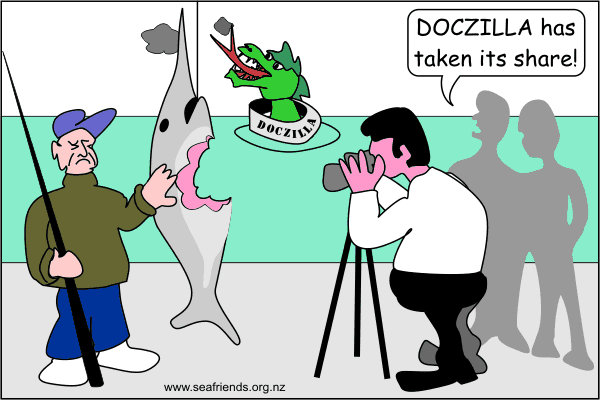 Some
fishers react to conservationists' demands for 10-30% of the sea locked
up forever, with a shrug of the shoulders: "We'll fish elsewhere, because
there is still 70-90% where we can fish". However, since marine reserves
have not shown any benefit to outlying areas due to perceived spill-over
or export of larvae, a 20% reduction in area also amounts to 20%
less fish to catch. It appears as if 20% has been taken from every fish
as we knew it, as the cartoon suggests. With catches amounting to over
1 billion dollar in export revenue, a 20% reduction also means loss of
opportunity for future generations and a hefty rent to pay. In addition,
the estimated number of jobs lost, amounts to over 1000. The number of
fishers having to fish elsewhere is in the order of tens of thousands.
So one should go about marine reserves in a cautious way, considering alternatives
and particularly what the most pressing threats to the sea are, which includes
land-based pollution. As pollution increases rapidly decade by decade
whereas fishing is controlled better and better, there is absolutely no
haste to rush for more reserves.
Some
fishers react to conservationists' demands for 10-30% of the sea locked
up forever, with a shrug of the shoulders: "We'll fish elsewhere, because
there is still 70-90% where we can fish". However, since marine reserves
have not shown any benefit to outlying areas due to perceived spill-over
or export of larvae, a 20% reduction in area also amounts to 20%
less fish to catch. It appears as if 20% has been taken from every fish
as we knew it, as the cartoon suggests. With catches amounting to over
1 billion dollar in export revenue, a 20% reduction also means loss of
opportunity for future generations and a hefty rent to pay. In addition,
the estimated number of jobs lost, amounts to over 1000. The number of
fishers having to fish elsewhere is in the order of tens of thousands.
So one should go about marine reserves in a cautious way, considering alternatives
and particularly what the most pressing threats to the sea are, which includes
land-based pollution. As pollution increases rapidly decade by decade
whereas fishing is controlled better and better, there is absolutely no
haste to rush for more reserves.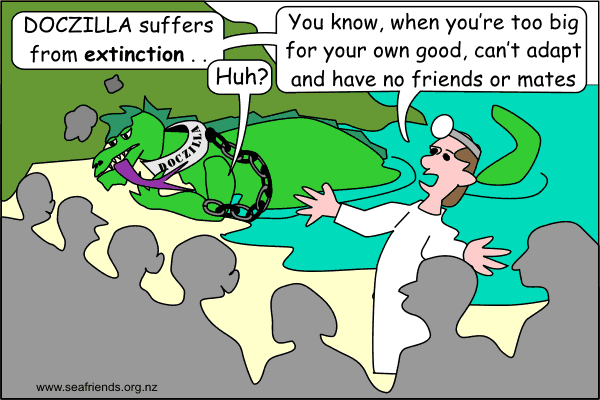 A
bureaucracy or government who pushes its own ideas without listening to
those of the public and those who know better, is destined for extinction
as history has proved time and again. In the past, the Department of Conservation
(DOCZILLA) has shown utter disregard for good process, and meaningful consultation
with those stakeholders who stand to lose most from marine reserves. But
one of DoC's barriers is not of its own making: the Marine Reserves Act
1971, which empowers it only for permanent no-take marine reserves.
Apart from the fact that marine reserves do no longer work in coastal seas
due to pollution, a permanent closure does not fix the problems in the
sea, while forever denying future generations its bounties. The real way
to save our seas is by improved fisheries management with various degrees
of conservation, a lot of education and some marine reserves where they
will work and where they are needed. This solution can be provided only
by the Fisheries Act, as the MRA (and DoC) cannot adapt. The last point
in this cartoon refers to the fact that good ideas can work only when they
find enough support in a friendly manner. Unfortunately for DoC, it has
made many permanent enemies. All these indicators imply that DoC's
time has passed and its extinction from the sea is imminent. DoC out
of the sea solves many problems.
A
bureaucracy or government who pushes its own ideas without listening to
those of the public and those who know better, is destined for extinction
as history has proved time and again. In the past, the Department of Conservation
(DOCZILLA) has shown utter disregard for good process, and meaningful consultation
with those stakeholders who stand to lose most from marine reserves. But
one of DoC's barriers is not of its own making: the Marine Reserves Act
1971, which empowers it only for permanent no-take marine reserves.
Apart from the fact that marine reserves do no longer work in coastal seas
due to pollution, a permanent closure does not fix the problems in the
sea, while forever denying future generations its bounties. The real way
to save our seas is by improved fisheries management with various degrees
of conservation, a lot of education and some marine reserves where they
will work and where they are needed. This solution can be provided only
by the Fisheries Act, as the MRA (and DoC) cannot adapt. The last point
in this cartoon refers to the fact that good ideas can work only when they
find enough support in a friendly manner. Unfortunately for DoC, it has
made many permanent enemies. All these indicators imply that DoC's
time has passed and its extinction from the sea is imminent. DoC out
of the sea solves many problems.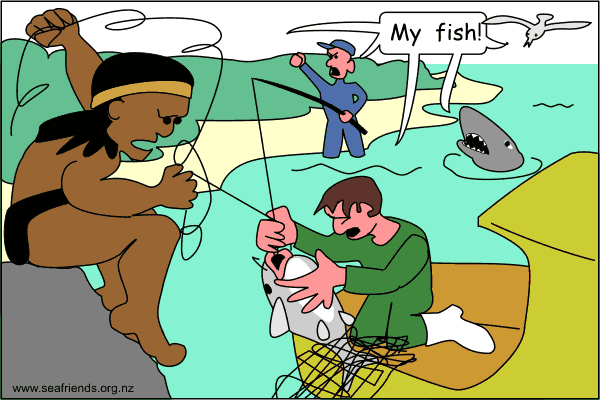 Conflicts
about resources arise only in times of scarcity, since while they were
bountiful before, there was simply enough for everyone. This cartoon shows
the reality of today and tomorrow, where the stake holders have to come
to an amicable agreement. These stakeholders do not only include commercial
and recreational fishermen but also the original people (and all our descendants),
and not least the large old fish in the sea, sea birds and sea mammals.
The only practical solution is to let fish stocks rebuild to much higher
levels, and set catch quota to below Maximum Sustainable Yield. This
does not necessarily mean smaller catches, but even if they are, the loss
in catch will be made good by a higher catch efficiency, fewer days at
sea, less fuel used and less risk for more profit. It is almost a win-win
situation, except that the marine environment will not be entirely pristine.
However, because people do not live in the sea, farm the sea soil and build
roads there, the sea will still be in much better shape than any of
our terrestrial world.
Conflicts
about resources arise only in times of scarcity, since while they were
bountiful before, there was simply enough for everyone. This cartoon shows
the reality of today and tomorrow, where the stake holders have to come
to an amicable agreement. These stakeholders do not only include commercial
and recreational fishermen but also the original people (and all our descendants),
and not least the large old fish in the sea, sea birds and sea mammals.
The only practical solution is to let fish stocks rebuild to much higher
levels, and set catch quota to below Maximum Sustainable Yield. This
does not necessarily mean smaller catches, but even if they are, the loss
in catch will be made good by a higher catch efficiency, fewer days at
sea, less fuel used and less risk for more profit. It is almost a win-win
situation, except that the marine environment will not be entirely pristine.
However, because people do not live in the sea, farm the sea soil and build
roads there, the sea will still be in much better shape than any of
our terrestrial world.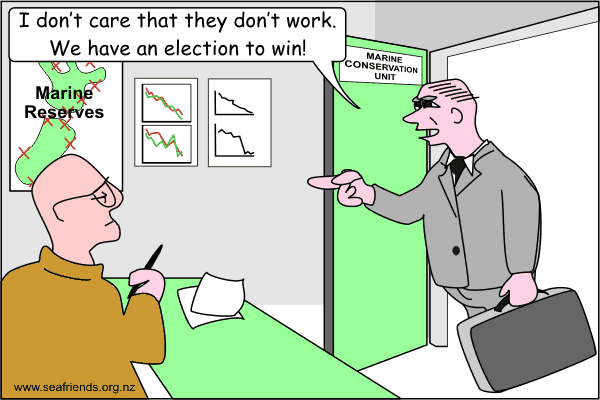 For
decades conservationists have been fighting public apathy and parliamentarians'
lack of enthusiasm for marine protection. The issue was clearly waiting
for a snowball effect, by which a public majority would demand marine reserves
from their politicians. At schools the simple mission that marine reserves
are good, finally became fruitful, resulting in a whole generation imbued
with the idea that we cannot have enough of them. Now politicians use marine
reserves to curry favour with their voters. Is that a good thing? Is it
desirable to have marine reserves to keep politicians in power? The answer
must be found in the poor performance of those reserves we already have:
they are degrading by losing both their quantity and quality of life. So
do we really need more of these feel-good reserves that do not deliver,
but that do restrict fishing effort? Having small reserves here and there,
as has been the case, does not hurt as much as the new ones, covering thousands
of square kilometres at a time. But will these work? The evidence suggests
that pollution there will not be any less as the underwater
environment already shows, so they too will degrade. Do you want marine
reserves to work for politicians or for the environment?
For
decades conservationists have been fighting public apathy and parliamentarians'
lack of enthusiasm for marine protection. The issue was clearly waiting
for a snowball effect, by which a public majority would demand marine reserves
from their politicians. At schools the simple mission that marine reserves
are good, finally became fruitful, resulting in a whole generation imbued
with the idea that we cannot have enough of them. Now politicians use marine
reserves to curry favour with their voters. Is that a good thing? Is it
desirable to have marine reserves to keep politicians in power? The answer
must be found in the poor performance of those reserves we already have:
they are degrading by losing both their quantity and quality of life. So
do we really need more of these feel-good reserves that do not deliver,
but that do restrict fishing effort? Having small reserves here and there,
as has been the case, does not hurt as much as the new ones, covering thousands
of square kilometres at a time. But will these work? The evidence suggests
that pollution there will not be any less as the underwater
environment already shows, so they too will degrade. Do you want marine
reserves to work for politicians or for the environment?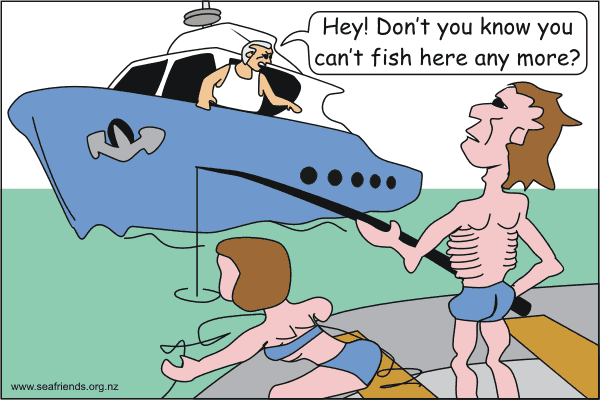 The
pain of a marine reserve where fishing is prohibited forever, is not felt
evenly throughout society. Those who clamoured for it loudest, are environmental
groups, few of whose members catch fish. Not surprisingly they do not feel
disadvantaged. Also those who are wealthy or mobile, suffer less because
they can fish somewhere else. So the ones most affected are the local commercial
fishermen who become displaced and those who fish for sustenance. In many
remote neighbourhoods, such as on islands, there is no fresh fish in the
shops, which makes sustenance fishing a necessity. Some elderly people
fish to supplement their modest pensions, and many unemployed poor have
no other option. Marine reserves thus must have some flexibility to accommodate
social justice. However, the Marine Reserves Act does not allow for this
kind of flexibility, an important reason for deep resentment. To what
extent should marine reserves also be socially just?
The
pain of a marine reserve where fishing is prohibited forever, is not felt
evenly throughout society. Those who clamoured for it loudest, are environmental
groups, few of whose members catch fish. Not surprisingly they do not feel
disadvantaged. Also those who are wealthy or mobile, suffer less because
they can fish somewhere else. So the ones most affected are the local commercial
fishermen who become displaced and those who fish for sustenance. In many
remote neighbourhoods, such as on islands, there is no fresh fish in the
shops, which makes sustenance fishing a necessity. Some elderly people
fish to supplement their modest pensions, and many unemployed poor have
no other option. Marine reserves thus must have some flexibility to accommodate
social justice. However, the Marine Reserves Act does not allow for this
kind of flexibility, an important reason for deep resentment. To what
extent should marine reserves also be socially just?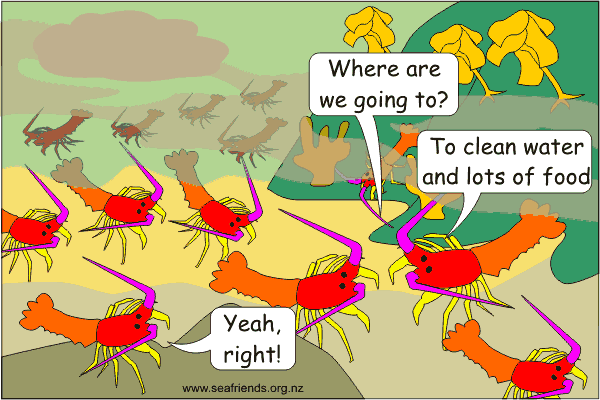 In
the spring of 1998 the crayfish in the Goat Island marine reserve showed
their dissatisfaction with turbid waters arising from prolonged muddy rain
storms, and they walked out in a big way: only one in six were found afterwards.
They did not get far, as the local fishermen reported good catches and
divers too were pleased. They said that the reserve was finally working
because the fish spilled out. This crayfish walk-out surprised many
because crayfish are very hardy. But they were not alone as other major
events had happened before in this most hallowed of all marine reserves.
In 1993 the whole kelp forest disappeared due to lack of light; then urchins
became ill; the grazing parore (Girella tricuspidata) became ill
and their numbers dwindled. There have been other foreboding signs, ignored
by scientists working there, all broadcasting the important lesson:
marine reserves do not protect against land-based pollution!
In
the spring of 1998 the crayfish in the Goat Island marine reserve showed
their dissatisfaction with turbid waters arising from prolonged muddy rain
storms, and they walked out in a big way: only one in six were found afterwards.
They did not get far, as the local fishermen reported good catches and
divers too were pleased. They said that the reserve was finally working
because the fish spilled out. This crayfish walk-out surprised many
because crayfish are very hardy. But they were not alone as other major
events had happened before in this most hallowed of all marine reserves.
In 1993 the whole kelp forest disappeared due to lack of light; then urchins
became ill; the grazing parore (Girella tricuspidata) became ill
and their numbers dwindled. There have been other foreboding signs, ignored
by scientists working there, all broadcasting the important lesson:
marine reserves do not protect against land-based pollution!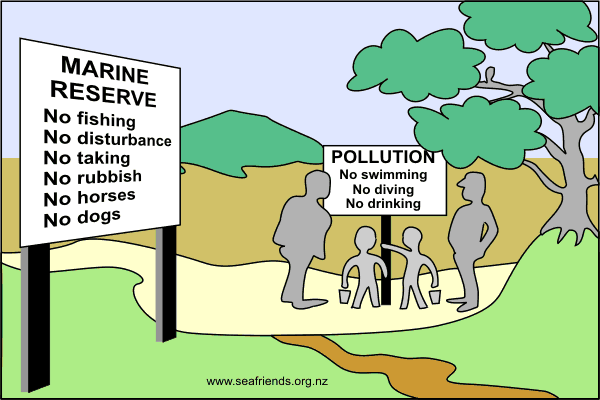 Nearly
all instances where our freedoms are curtailed, are related to there being
too many of us. Measures to protect fish are needed because there are too
many fishers and too many people needing their catches. Popular beaches
are closed to horses and dogs because these could offend too many of us.
As we become more numerous while nature shrinks, simple nuisances become
threats, such as polluted waters becoming poisonous. Because humans live
essentially above sea level, it does not directly affect us, although this
could only be a matter of time. Poisons accumulate slowly in fish and then
slowly in those who eat fish, until suddenly a threshold is passed, like
the proverbial droplet that makes the bucket flow over. By then it will
be too late to alter the course of events. It is thus important to acknowledge
early symptoms, to understand them, and to act accordingly.
Nearly
all instances where our freedoms are curtailed, are related to there being
too many of us. Measures to protect fish are needed because there are too
many fishers and too many people needing their catches. Popular beaches
are closed to horses and dogs because these could offend too many of us.
As we become more numerous while nature shrinks, simple nuisances become
threats, such as polluted waters becoming poisonous. Because humans live
essentially above sea level, it does not directly affect us, although this
could only be a matter of time. Poisons accumulate slowly in fish and then
slowly in those who eat fish, until suddenly a threshold is passed, like
the proverbial droplet that makes the bucket flow over. By then it will
be too late to alter the course of events. It is thus important to acknowledge
early symptoms, to understand them, and to act accordingly.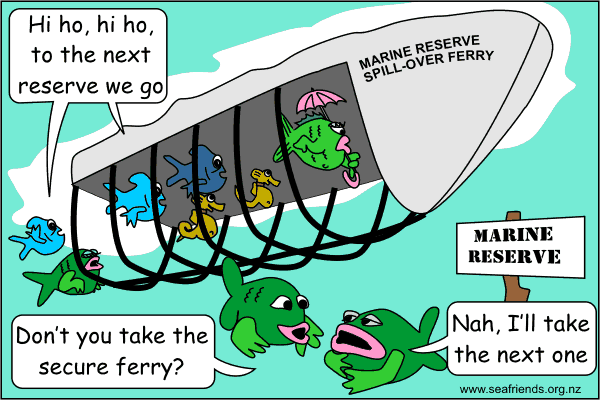 Some
scientists make much ado about the spill-over effect from protected
areas, in the form of fish migrating out and their spawn drifting out on
currents. They imagine the rest of the sea as a dangerous desert with baited
fish hooks dangling everywhere. Networks of protected areas, they
reason, would reinforce one another by being connected through invisible
corridors. Such connectivity would enhance the resilience
of each node in the network, and thus the sustainability of the
whole. The cartoon suggests how such a safe corridor could be maintained,
but the reality is that these wonderful ideas have not been shown to be
true, and most likely never will. Because of the lack of predators between
protected areas, this desert would be a haven for young recruits (those
just settled out of their planktonic youth) and they in turn would tempt
predators out of their reserves. Networks of marine reserves work only
in our minds!
Some
scientists make much ado about the spill-over effect from protected
areas, in the form of fish migrating out and their spawn drifting out on
currents. They imagine the rest of the sea as a dangerous desert with baited
fish hooks dangling everywhere. Networks of protected areas, they
reason, would reinforce one another by being connected through invisible
corridors. Such connectivity would enhance the resilience
of each node in the network, and thus the sustainability of the
whole. The cartoon suggests how such a safe corridor could be maintained,
but the reality is that these wonderful ideas have not been shown to be
true, and most likely never will. Because of the lack of predators between
protected areas, this desert would be a haven for young recruits (those
just settled out of their planktonic youth) and they in turn would tempt
predators out of their reserves. Networks of marine reserves work only
in our minds!